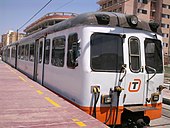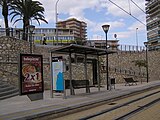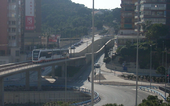4109 Benidorm 1.10.2015
Route through La Vila Joiosa 1.10.2015
Seafront route near Les Llances 1.10.2015
4211 Alicante/Alacant Mercado 1.10.2015
4212 Alicante/Alacant Mercado 1.10.2015
(All pics © Steve Sainsbury/Rail Thing)
We were away in Spain last week, staying at a top hotel in Benidorm (highly recommended by the way!) I was keen to see the modern light railway network that serves Benidorm. It consists of two sections, an electrified route to Alicante (where there are an additional three routes serving urban areas), and the diesel line to Denia (which is just starting the process of being electrified).
The first trip was to Alicante(Alacant in the local Valencian language). The line runs through a mix of almost empty, almost desert countryside, and through small towns and seaside villages, with some roadside running (but no street running) before diving underground in Alicante to serve the city.
There is an half hourly service and the trams are busy. There is a mix of single and double track, the section around Alicante carries up to four routes, so this section is intensively worked. The trip takes 70 minutes, a comfortable journey in the modern trams used by the line.
More info (from Wikipedia)
The Alicante Tram, trademarked as Alicante Metropolitan TRAM (Valencian: TRAM Metropolità d'Alacant, Spanish: TRAM Metropolitano de Alicante),[a][b] operates in the Spanish city of Alicante(Valencia) and its surrounding area. Like other narrow gauge railways in the Valencian Community, it is run by Ferrocarrils de la Generalitat Valenciana (FGV). It was inaugurated on 15 August 2003 replacing narrow-gauge diesel trains between Alicante and El Campello.
The Alicante Metropolitan Tram light rail combines different modes of rail services: a partially underground modern tramway through Alicante city centre, a tram-train from Alicante to Benidorm, and conventional commuter rail from Benidorm to Altea, Calp and Dénia.
History
There has been a rich history of urban rail service in Alicante. The tram service began on 13 July 1893 and the network was rapidly expanding to Mutxamel (1902), Elche and Crevillent (1905) and San Vicente del Raspeig (1906). Initially, the streetcars were horse-drawn. Since 1903 the trams were carried as well by the power of steam engine, leading to the disappearance of the horse-drawn trams by 1924. The electrification of tram lines began in 1923. In 1920s and 30s the network was further expanded throughout the city and was extensively used in 1940s. In 1950s, due to high costs of electricity, trams were gradually losing the competition against growing automobile services and by 14 November 1969 they completely disappeared from the streets. Thirty years later, on 13 March 1999 the trams were back with the inauguration of an experimental route between Plaza del Mar and Albufereta that was extended to El Campello in 2003.
Lines
The network comprises the following lines:
- L1 (tram-train), limited-stop service from Alicante city centre to Benidorm (70 minutes). In Benidorm it connects with line L9 to Dénia.
- L2 (tram), from the city centre to the General Hospital of Alicante, the University of Alicante and San Vicente del Raspeig (15 minutes).
- L3 (tram), stopping service from Alicante to El Campello (30 minutes).
- L4 (tram), from the city centre to a loop in Playa de San Juan district (30 minutes).
- 4L (tram), from Alicante port: discontinued 30 June 2013, Puerta del Mar through the site of the former FGV Railway station of La Marina to Sangueta, where it used to connect with Lines L1, L3, and L4 (no service).
- L9 (diesel train), from Benidorm along the coast to Dénia, stopping at other important tourist towns like Altea and Calp. Services are subject to disruption due to engineering works as the line is prepared for electrification (60 minutes).
Lines L1, L2, L3 and L4 share the city centre underground section between MARQ and the city centre Luceros station. The Mercado (Valencian: Mercat) station on the segment was opened on 10 May 2007 and the Luceros was opened on 18 June 2010.
Construction and plans
The underground section has been constructed to continue westward to Estació Multimodal serving the Adif station (and a possible relocation of the bus station).
Line L2 (tram), using the same underground stretch as lines L1, L3 and L4, now connects the centre of Alicante with the University of Alicante in San Vicente del Raspeig.
There are plans to extend the tram-train service southwards to Alicante Airport, El Altet, Elche, Gran Alacant, Santa Pola, Guardamar and Torrevieja. According to the local press it seems unlikely that any of these extensions will be built in the near future due to lack of funds.
Gallery
underground stations
ground stations





















No comments:
Post a Comment